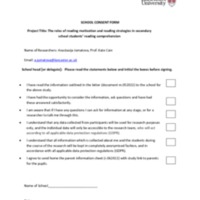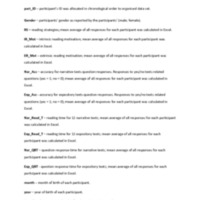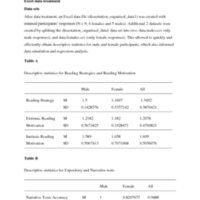The roles of reading motivation and reading strategies in secondary school students’ reading comprehension
Dublin Core
Title
The roles of reading motivation and reading strategies in secondary school students’ reading comprehension
Creator
Anastasija Jumatova
Date
28/09/2022
Description
The aim of the study was to investigate comprehension and inference ability in relation to text genre, reading strategies, intrinsic and extrinsic reading motivation, and gender in mainstream secondary school UK students. Data were collected from a sample of 27 participants; retained data of 9 secondary school students (5 males, 4 females) data were used for the study analysis. These responses were used to inform a simulated dataset for the analysis. The participants completed an online study, which measured their intrinsic and extrinsic reading motivation The Motivation for Reading Questionnaire (MRQ; Wang & Guthrie, 2004), comprehension and inference ability of narrative and expository texts (Currie et al., 2021), and reading strategies (Denton, Wolters, et al., 2015). Due to sample size limitations the decision was made to simulate individual datasets for reading strategies, intrinsic reading motivation, extrinsic reading motivation, narrative texts, and expository texts by gender, following the simulation methods proposed by Muldoon (2019). The results of the study revealed that female participants scored lower on reading strategies and demonstrated poorer performance for narrative and expository texts. There was no gender difference found for reading motivation. These findings will be discussed in relation to our understanding of gender differences in inferential reading comprehension, reading motivation and practical implications for the classroom.
Subject
reading comprehension; reading inference; reading motivation; expository and narrative texts; secondary school
Source
Participants The intention was to collect original data from UK Year 7, 8, 9, and 10 mainstream secondary school students. This was through schools and word of mouth. Unfortunately, schools who were approached were not able distribute the study information in time for data collection before the summer break. In total 27 students started the study and completed data was collected from 9 (5 males, 4 females; M age = 13.83 years, SD = 2.45). These data were used to inform a simulated dataset to test the study predictions.
Materials Reading Motivation To assess students’ reading motivation 7 out of 8 domains from “The Motivation for Reading Questionnaire” (MRQ): A Revised Version (Wang & Guthrie, 2004) were used (grades domain from extrinsic scale was removed). The forty-one-question scale measured extrinsic and intrinsic motivation. Intrinsic motivation consisted of three domains: curiosity (7 items), involvement (7 items), and preference for challenge (5 items). Seven scales (curiosity, involvement, challenge, recognition, social and competition) reported good internal consistency (Cronbach’s alpha ˃ .70; Wang and Guthrie, 2004). An example of intrinsic motivation item: “I enjoy a long, involved story or fiction book”. Extrinsic motivation measured the following four domains: recognition (5 items), social (7 items), competition (6 items), and compliance (4 items). An example of extrinsic motivation item: “I like having my friends sometimes tell me I am a good reader”. Each statement had four possible answers, which were assigned values from 0 to 3 (very different from me = 0, a little different from me = 1, a little like me = 2, a lot like me = 3), and participants were asked to select the most appropriate for them. Scoring for negative item 40 was reversed before assigning the values. Text Genre Participants were asked to read 12 narrative, and 12 expository texts. Narrative texts focussed on human characteristics and activities, based on interactions with different social groups, as families, friends, peers at schools and youth clubs. Expository texts, were science-based, underpinned by chemistry, physics, biology, and geology. Each text consisted of 7 sentences, with 2 critical sentences that required an inference in order to integrate their meanings. The distance between two critical sentences was varied – either adjacent or separated by up to 3 sentences of filler text to minimise the detection of any pattern by readers, which might result in a focus on just the critical sentences, rather than reading the text as a whole. Each text was followed by one question, requiring choosing one answer from yes/no options (correct answer was allocated a value = 1; incorrect answer = 0), which assessed participant’s inference ability and comprehension. Participants completed two practice items, one expository and one narrative text, before starting the test. Reading Strategies Reading strategy knowledge was assessed with items from the Contextualized Reading Strategy Survey (CReSS; Denton et al., 2015). In this, participants read situation-based reading scenarios and rate how frequently they use different reading strategies in those situations. The three selected scenarios assessed reader’s construction integration abilities (Kintsch, 1988). An example of a scenario used for the study “As a homework assignment for your English class, you have been asked to read a story from your textbook. Tomorrow your teacher will give you a quiz about the story. Which of these things do you do to help you understand a story while you are reading or after reading?”. The following strategies were displayed for students to choose from “I try to make mental pictures of the information in the story while I read. While I am reading, I think about how the parts of the story go together. I think about what the characters are doing in the story and why they are acting as they are. I predict what I think will happen next. I think about how this story is like other stories I have read”. Each strategy had four response options, with values assigned from 0 to 3 (I almost never do this = 0; I sometimes do this = 1; I usually do this = 2; I almost always do this = 3) for participants to choose the one, which they use the most.
Procedure The study was hosted on Qualtrics platform. First, the parents/ guardians accessed the study via a link, then they provided their consent. The child saw the next screen, where they read the information about the study and provided their assent. Participants were asked to complete the task at home in their own time, outside of their school commitment time. Participants were asked to provide information about their gender, age - month and year only. Task order was: (1) reading strategies, (2) narrative texts with yes/no questions about the texts, (3) expository texts with yes/no questions about the texts, and (4) intrinsic and extrinsic reading questionnaire. For the reading strategies questionnaire, participants were asked to read 3 scenarios, as described above. They read each scenario and then indicated on a 4-point Likert scale how frequently they used each strategy. To assess inference making, participants read 12 short narrative texts, and also 12 short expository texts. Each text was shown on 1 screen with the inference-tapping question on a separate screen. They pressed a button next to YES or NO to provide their answer. The final task required participants to complete a reading motivation questionnaire. They read 19 statements for intrinsic and 22 statements for extrinsic reading motivation, and then indicated on the 4-point Likert scale how likely of them it was, as described above. The whole procedure took approximately 30 minutes. Collected data was stored in password-protected file, on password-protected Master student’s Lancaster University’s Office 360, accessed through password-protected laptop.
Ethical Considerations The research was approved by the University Department Ethics Committee, and conducted in line with the Lancaster University ethics guidelines: https://www.lancaster.ac.uk/sci-tech/research/ethics/, and the BPS Code of Ethics and Conduct (2018). Measures were taken to maintain the participants’ anonymity: identifiable information as participant’s name, school name, participant’s full date of birth were not collected; with references to data collection in England. To investigate the study purposes of age and gender related differences, participant’s month and year of birth were obtained, and the student’s gender as reported by participant were collected.
Publisher
Lancaster University
Format
Data/csv.
Identifier
Jumatova2022
Contributor
Wai Man Ko, Charlotte Graham
Rights
Open
Relation
N/A
Language
English
Type
Data
Coverage
LA14YF
LUSTRE
Supervisor
Prof. Kate Cain
Project Level
MSc
Topic
Cognitive, Developmental
Sample Size
9 participants. Data simulation using set.seed(16) function in R Studio was used to create a larger sample and simulate data analysis
Statistical Analysis Type
Regression, other
Files
Collection
Citation
Anastasija Jumatova , “The roles of reading motivation and reading strategies in secondary school students’ reading comprehension,” LUSTRE, accessed December 16, 2025, https://www.johnntowse.com/LUSTRE/items/show/165.



